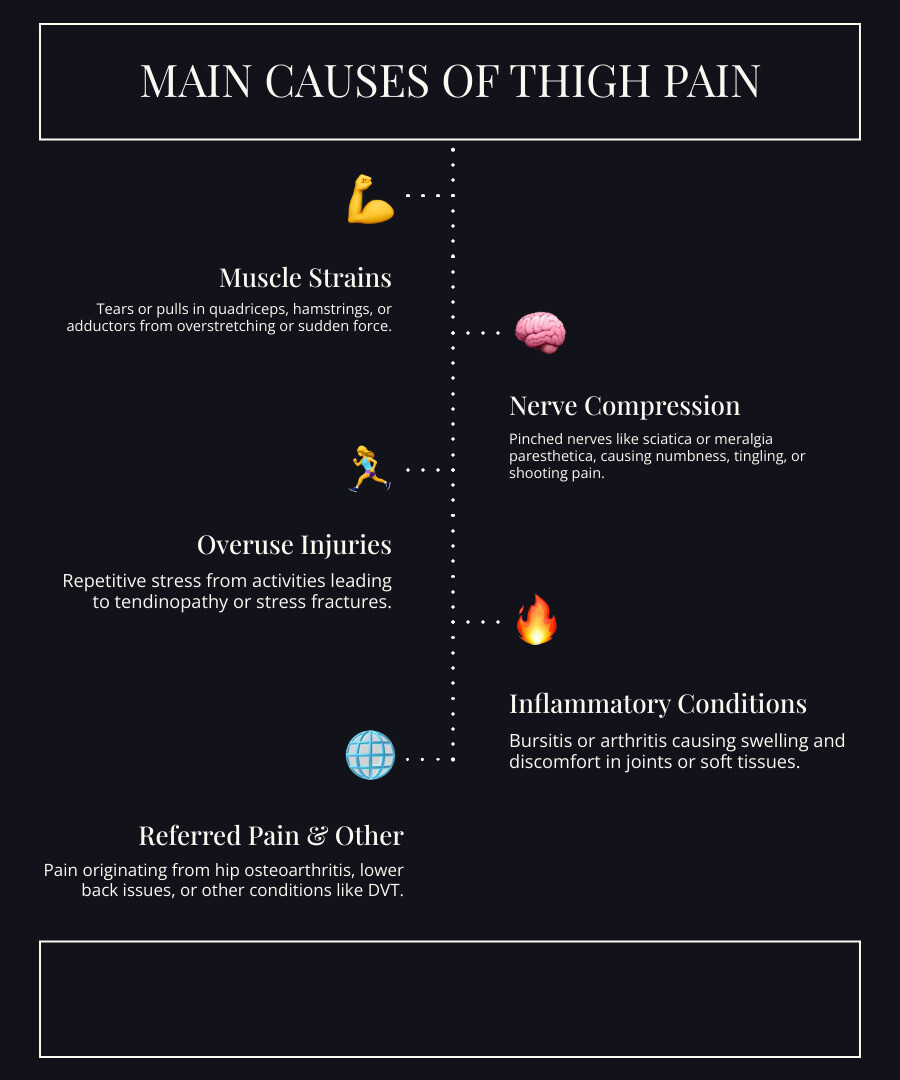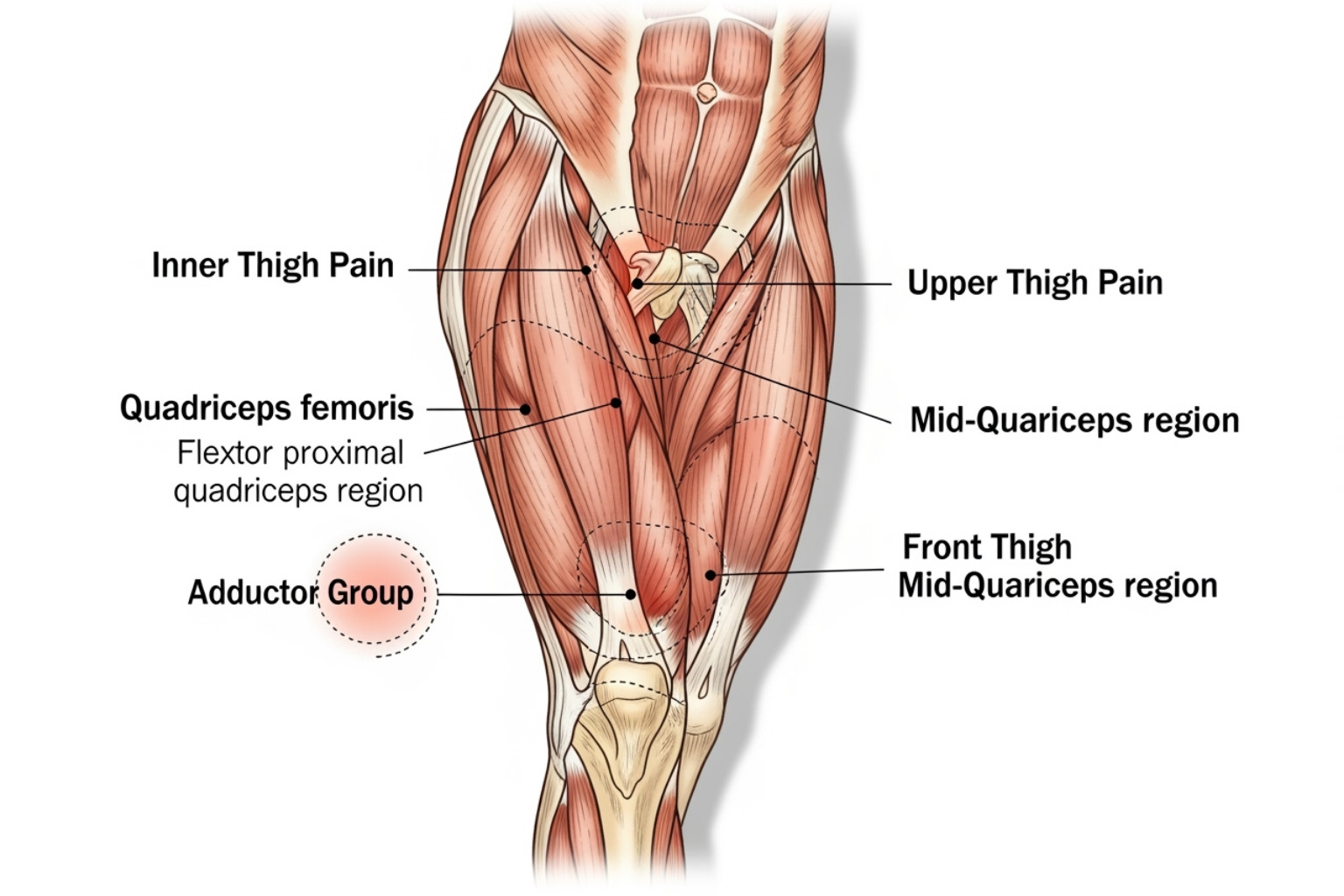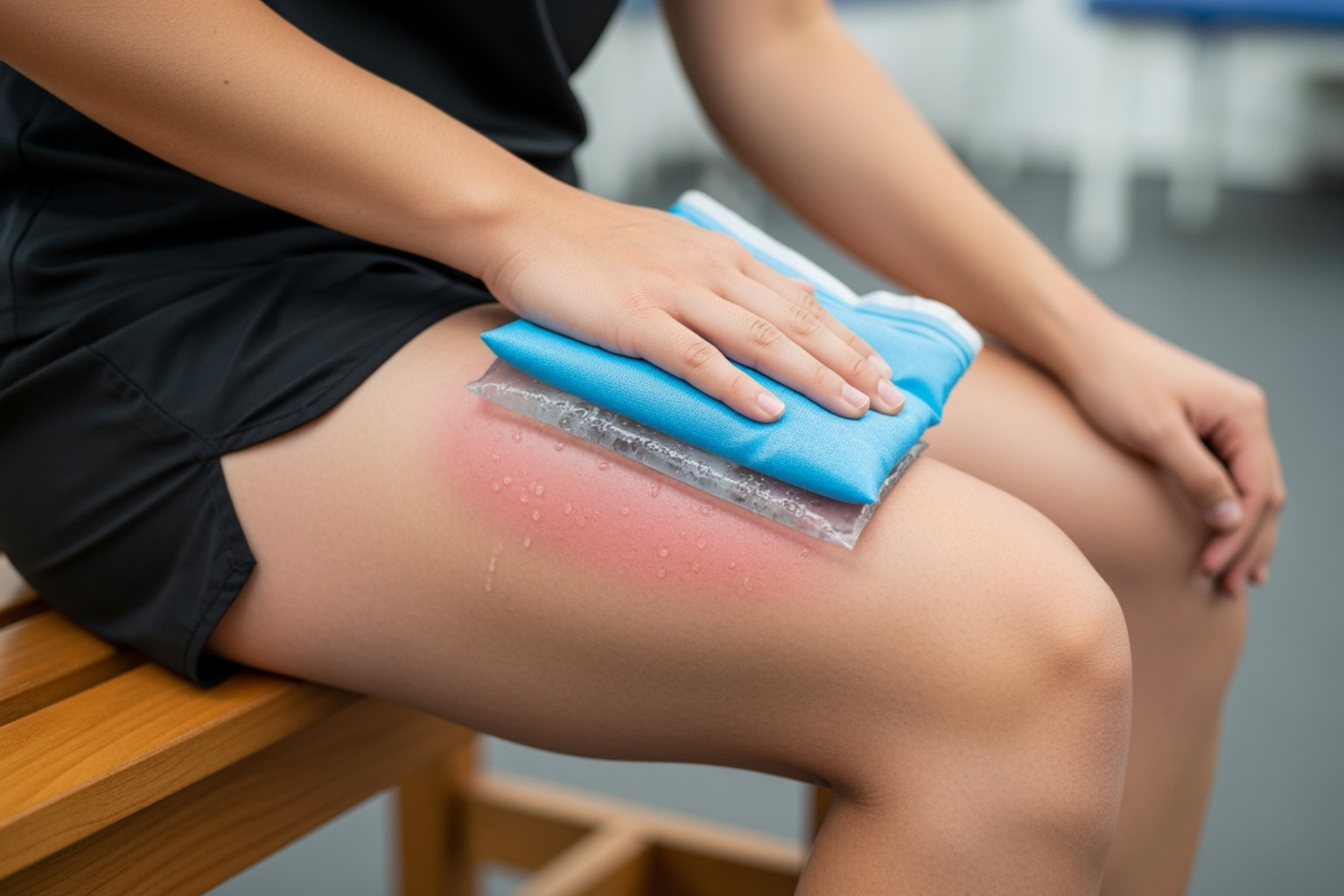Why Understanding Thigh Pain Relief Matters for Your Active Life
Effective thigh pain relief begins with identifying the cause and knowing your treatment options. Your thighs—quadriceps, hamstrings, and adductors—power your lower body, supporting your weight and enabling movement.
Quick Relief Options:
- RICE Method - Rest, Ice, Compression, Elevation for acute injuries
- Heat Therapy - For muscle stiffness and chronic pain after 48-72 hours
- Topical Pain Relief Creams - Fast-acting ingredients like menthol and lidocaine
- Gentle Movement - Promotes blood flow and prevents stiffness
- Professional Evaluation - When pain persists or worsens
When pain strikes, it can disrupt daily life, making simple tasks challenging. However, movement is a key part of recovery, with studies showing significant pain reduction through consistent, proper techniques. This guide offers proven strategies for everything from muscle strains to chronic stiffness.
About the Author
I'm Tony Enrico, and I've dedicated my career to helping active individuals overcome pain. Through developing advanced formulas like Neuropasil, I've seen how targeted thigh pain relief strategies can restore an active, pain-free life.

Thigh pain relief glossary:
- immediate relief for sciatica pain
- pinched nerve in lower back
- sciatica symptoms
Decoding the Source of Your Thigh Pain
Effective thigh pain relief requires identifying the source. The location, intensity, and type of pain offer clues to the underlying issue, whether it's a muscle strain, overuse injury, or a nerve problem. Sometimes, the pain originates elsewhere, like the hip or lower back. Understanding these patterns is the first step toward the right treatment.

Common Causes and Symptoms
The thigh's main muscle groups—the quadriceps (front), hamstrings (back), and adductors (inner)—often suffer from muscle strains, which are tears in muscle fibers from overstretching.
- Adductor strains (groin pulls): Cause sharp pain in the inner thigh, especially when pivoting or bringing legs together.
- Hamstring injuries: Result in sudden, sharp pain in the back of the thigh, often with a "popping" sound, swelling, and bruising.
- Quadriceps injuries: Affect the front of the thigh, causing pain, swelling, and difficulty straightening the leg.
Sometimes, thigh pain is referred from other areas. Hip osteoarthritis can cause referred pain felt in the groin and upper thigh.
Nerve issues cause distinct sensations like burning, tingling, or numbness.
- Meralgia paresthetica: Affects the outer thigh due to pressure on the lateral femoral cutaneous nerve, often from tight clothing or weight gain.
- Sciatica: Occurs when the sciatic nerve is irritated, sending shooting or burning pain from the lower back down the back of the thigh. Learn more in our guide on sciatic nerve pain.
Understanding whether you're dealing with muscle or nerve pain is crucial for finding the right thigh pain relief approach:
| Symptom Feature | Muscle Strain | Nerve Pain |
|---|---|---|
| Onset | Often sudden, during activity | Can be sudden or gradual |
| Sensation | Sharp, aching, pulling, tearing | Burning, tingling, numbness, shooting, electric shock-like |
| Location | Localized to a specific muscle area | Can radiate along a nerve pathway |
| Aggravating Factors | Movement, stretching, contracting affected muscle | Specific postures, prolonged sitting, bending/twisting |
| Relieving Factors | Rest, ice, gentle stretching (after acute phase) | Changing position, gentle movement, nerve gliding exercises |
| Associated Symptoms | Swelling, bruising, tenderness, muscle spasm | Weakness, altered sensation (pins and needles) |
Upper Thigh Pain vs. Inner Thigh Pain
The location of your pain helps pinpoint the cause.
Upper thigh pain often involves more than just muscles.
- Ischial bursitis: Causes pain at the "sit bone," especially after prolonged sitting (Johnson DB, et al., 2022).
- Greater trochanteric pain syndrome: Affects the outer upper thigh and hip, common in runners.
Inner thigh pain typically relates to the groin area.
- Adductor tendinopathy: Persistent pain from overuse of inner thigh muscles.
- Osteitis pubis: Inflammation of the pubic bone, common in athletes.
- Groin strains: Sharp pain in the inner thigh from sudden movements. A hernia can also sometimes cause inner thigh pain.
For more on hip-related discomfort, see our guide on hip muscle pain.
Understanding these pain patterns is your first step toward targeted, effective relief. Next, we'll explore immediate strategies you can use at home.
Immediate At-Home Strategies for Thigh Pain Relief
When you need immediate thigh pain relief, several at-home strategies can help. The key is matching the treatment to the type of pain. The RICE method (Rest, Ice, Compression, Elevation) is the standard for acute injuries, recommended by health authorities for managing sprains and strains (NHS Inform, 2023). Rest prevents further damage, Ice reduces swelling and pain, Compression provides support, and Elevation helps drain fluid.

Using Ice and Heat Therapy
Ice therapy (cryotherapy) constricts blood vessels, reducing swelling and numbing pain. Use it for fresh injuries with swelling during the first 48-72 hours. Apply an ice pack wrapped in a towel for 15-20 minutes at a time.
Heat therapy (thermotherapy) dilates blood vessels, increasing blood flow to relax tight muscles and speed healing. It's best for chronic stiffness and soreness after the initial swelling has subsided. Apply heat for 15-20 minutes. Always use a barrier to protect your skin and follow the 20-minute rule for both.
Topical Relief Options
For targeted relief, topical pain relief creams deliver active ingredients directly to the source of discomfort. Neuropasil Nerve Pain Relief Cream uses a natural formula with Aloe, Urea, and Menthol to provide soothing, penetrating relief. Ingredients like Menthol create a cooling sensation that distracts from pain signals. This approach is effective for nerve-related pain, muscle strains, and deep aches.
While healing, modify activities to avoid worsening the pain, but incorporate gentle movement to aid recovery. Learn more about Muscle Pain Cream Comparisons and What Helps Sore Muscles in our comprehensive guides.
Active Recovery: Exercises and Professional Guidance
While rest is vital initially, prolonged inactivity can hinder recovery. Gentle movement is crucial for thigh pain relief, acting like medicine for your muscles. It increases blood flow, delivering oxygen and nutrients essential for healing. In fact, structured movement plans have been shown to reduce pain by an average of 68% in 12 weeks.
Effective Exercises for Thigh Pain Relief
Once acute pain subsides, introduce these gentle exercises. Hold each stretch for 20-30 seconds without forcing it.
- Standing Quad Stretch: For the front of the thigh. Use a wall for balance, bend one knee, and gently pull your heel toward your glutes.
- Standing Hamstring Stretch: For the back of the thigh. Step one foot forward, heel down. Hinge at your hips with a straight back until you feel a stretch.
- Lying Knee Bend: Lie on your back and slowly slide one heel toward your glutes, bending the knee comfortably.
- Butterfly Stretch: Sit with the soles of your feet together and let your knees fall to the sides to target the inner thighs.
- Foam Rolling: A form of self-massage to release knots in your quadriceps, hamstrings, and inner thighs. Roll slowly over tender spots.
For more, see these Simple Stretching Exercises to Deal with Thigh Pain. Consistency is more important than intensity.
The Role of Professional Guidance
Sometimes, professional guidance is necessary for lasting thigh pain relief. A healthcare professional can provide:
- Personalized Assessment: To identify muscle imbalances and create a custom exercise plan.
- Manual Therapy: Hands-on techniques like targeted massage to reduce pain and improve mobility.
- Therapeutic Modalities: Treatments like TENS units to block pain signals.
- Posture and Movement Correction: To address root causes of pain stemming from daily habits.
- Guided Return to Activity: A structured plan to prevent re-injury and ensure a full recovery.
When to See a Doctor: Recognizing Red Flags
While home care is often effective, certain red flags warrant a doctor's visit. Seek professional help for:
- Pain that doesn't improve after a week of home treatment.
- Inability to bear weight on the affected leg.
- Sudden, severe pain without a clear cause.
- Significant swelling, redness, or warmth, especially with a fever (could be infection or a blood clot).
- Numbness, tingling, or weakness that extends down your leg, suggesting nerve involvement.
Diagnostic Process
A doctor will diagnose the cause of your pain through a systematic process:
- Physical Examination: To assess range of motion, strength, and locate tenderness or swelling.
- Medical History: To understand when the pain started, potential triggers, and your overall health.
- Diagnostic Tests: If needed, your doctor may order tests to determine the underlying cause, such as X-rays for bone issues, MRIs for soft tissue damage, ultrasound for blood clots, or EMG to assess nerve function.
Serious Conditions to Rule Out
While most thigh pain is not serious, it's important to rule out certain conditions:
- Deep Vein Thrombosis (DVT): A blood clot in a deep vein, causing aching pain, swelling, and warmth. This is a medical emergency.
- Peripheral Arterial Disease (PAD): Narrowed arteries reducing blood flow, causing pain during exercise.
- Severe Muscle Tears or Fractures: Cause intense pain and inability to bear weight.
- Infection: Indicated by spreading redness, warmth, and fever.
Since lower back issues can refer pain to the thigh, understanding Lower Back Pain Causes can also be helpful. Trust your instincts; if something feels seriously wrong, seek medical evaluation.
Frequently Asked Questions about Thigh Pain
Here are answers to some of the most common questions about thigh pain.
How long does a thigh strain take to heal?
Healing time for a thigh strain depends on its severity, according to the American Academy of Orthopaedic Surgeons (AAOS):
- Grade 1 (Mild): Minor fiber tearing. Heals in 10 days to 3 weeks.
- Grade 2 (Moderate): More significant tearing with pain and swelling. Takes 3 to 6 weeks.
- Grade 3 (Severe): A complete muscle rupture. May take up to 6 months and can require surgery.
Recovery is influenced by your age, fitness, and how well you adhere to rest and treatment.
Can sitting for too long cause thigh pain?
Yes, prolonged sitting is a common cause of thigh pain (Sacksy Thyme). It leads to:
- Muscle Imbalances: Your hip flexors tighten while your glutes weaken, creating strain.
- Nerve Compression: Sitting can put pressure on nerves like the sciatic nerve or cause Meralgia paresthetica (burning on the outer thigh).
- Reduced Blood Flow: This can cause muscles to feel achy and stiff.
To combat this, take frequent "movement snacks"—short breaks every 30 minutes to stand, walk, or stretch.
What is the fastest way to get thigh pain relief?
The fastest thigh pain relief comes from a combined approach custom to the cause:
- For Acute Injuries: Use the RICE method immediately to reduce pain and swelling.
- For Chronic Stiffness: Apply heat therapy and perform gentle movement to increase blood flow and relax muscles.
- For Targeted Relief: A topical cream like Neuropasil Nerve Pain Relief Cream can provide fast-acting comfort directly at the source.
"Fastest" isn't always best for long-term healing. If pain is severe or persistent, the quickest path to recovery is a proper medical evaluation.
Conclusion and Next Steps
Thigh pain doesn't have to control your life. By using the right strategies, you can find relief and get back to your routine. Movement is medicine; gentle stretches and exercises are powerful healing tools. Combine smart movement with immediate relief tactics like the RICE method for fresh injuries or heat therapy for stubborn stiffness.
Most importantly, listen to your body's signals. They will guide you toward what you need, whether it's rest, movement, or targeted relief. For that targeted relief, a topical solution like Neuropasil offers a natural, fast-acting cream that works directly where it hurts.
Be proactive in your recovery. Don't wait for pain to become unbearable, and seek professional help for any red flag symptoms. Your active, pain-free life is achievable with the right approach and effective solutions like Neuropasil for thigh pain relief.
Find lasting relief and explore our solutions
References
The information in this guide is supported by the following credible medical and health sources cited throughout the article:
- American Academy of Orthopaedic Surgeons (AAOS): "Muscle Strains in the Thigh"
- Dibra, F. F., et al. (2017): "Don't forget the hip! Hip arthritis masquerading as knee pain" (via PubMed)
- Healthline: "Pain in Upper Thigh: 9 Causes, Symptoms, and Treatment"
- Hinge Health: "If You Have Inner Thigh Pain, Try This"
- Johnson, D. B., et al. (2022): "Ischial Bursitis" (via StatPearls)
- Liebscher & Bracht: "Simple Stretching Exercises to Deal with Thigh Pain"
- NHS Inform (Scotland): "Thigh problems"
- Sacksy Thyme: "How to Deal with Thigh Pain When Sitting"
Note: This article also references other pages on Neuropasil.com and its affiliated sites for related topics, which are linked directly in the text.















